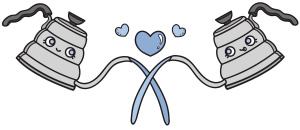The Mechanics of Pouring
The Arc of Pouring
When using a pouring kettle, it is very difficult to create a stream that is slow enough that it enters the slurry as a perfectly vertical stream. For most percolation recipes, the flow rate requirements are such that the stream of water will always have a slight arc towards the direction your spout is pointing. In tests using a Hario buono pouring kettle, it is not until we pour at 3 ml/second that we manage to achieve a flow rate that appears to drop vertically into the slurry. This level is too slow to be practical for most commercial settings. The likelihood is that most pour-over recipes encourage a slight unevenness in the arrangement of the coffee bed. We suggest that some manual agitation is necessary to correct this after you have completed the dilution phase. We explore this subject of turbulence more in lesson 3.04 and you can refer to this White Paper by physicist Jonathan Gagne, if you wish to explore the physics of kettle streams in detail.
Pouring Close to the Surface
A lesson in pouring kettle technique that translates over from latte art is that pouring at close range to the surface of the liquid reduces the amount of turbulence you create. With latte art, when it comes time to apply a design onto the surface of a drink in a way that avoids the liquid penetrating beneath the surface we drop down to within 1 cm of the surface. That results in the least likelihood of the liquid picking up enough speed to drop beneath the surface. However, this also creates some forward momentum towards the side of the cup that the spout of the pouring kettle is pointing to. This is not an issue for latte art, but with pour-over coffee, it can result in a coffee bed that slopes downwards in the direction of the flow.
